My Ultimate Guide to Train Travel in India
The best way to travel India is by the vast, and great value, Indian Railways network and traveling on Indian railways is an essential Indian bucket list experience in itself.
However, this massive system can be confusing to navigate at first and tickets can get booked up way in advance and can be difficult to book from abroad.
But never fear, read on and I’ll explain everything you need to know in this ultimate guide to train travel in India including how to book train tickets in India (even from abroad) and all the tips you need for traveling by train in India
I’ve been traveling around India independently, on a budget, and mostly as a solo female traveler since 2013. In my ultimate guide to train travel in India I’ll introduce you to Indian Railways and guide you through how to book train tickets in India.
As Indian trains get fully booked weeks and months in advance, I will also show you how to book train tickets in India in advance even from abroad to ensure a smooth trip.
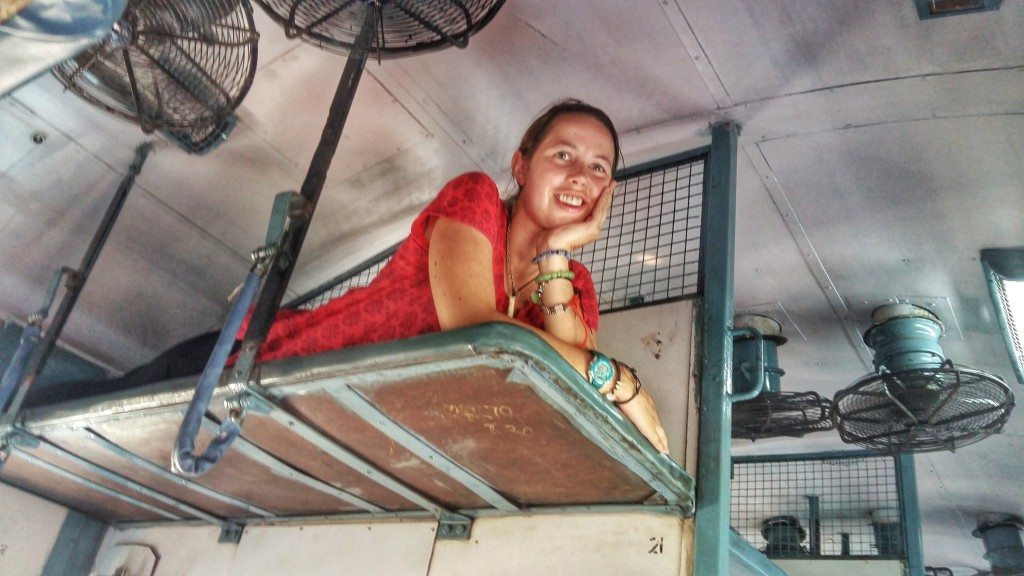
I will explain all the different ticket types and 8 classes found on Indian Railways. Do you need to know what a Taktal ticket is? What is the different between AC2 and AC3? Should you join a Wait List? Is sleeper class really that bad? All the answers are here…
I’ve also written down all my tips for traveling by rail in India and answered your questions and queries about how to find your seat, food, safety, scams and of course the state of the toilets on Indian trains!
It’s a long post (Indian Railways is one of the largest and busiest rail networks in the world after all!) so grab a chai and settle down and I’ll explain all you need to know about train travel in India!
Pin Me! 🙂
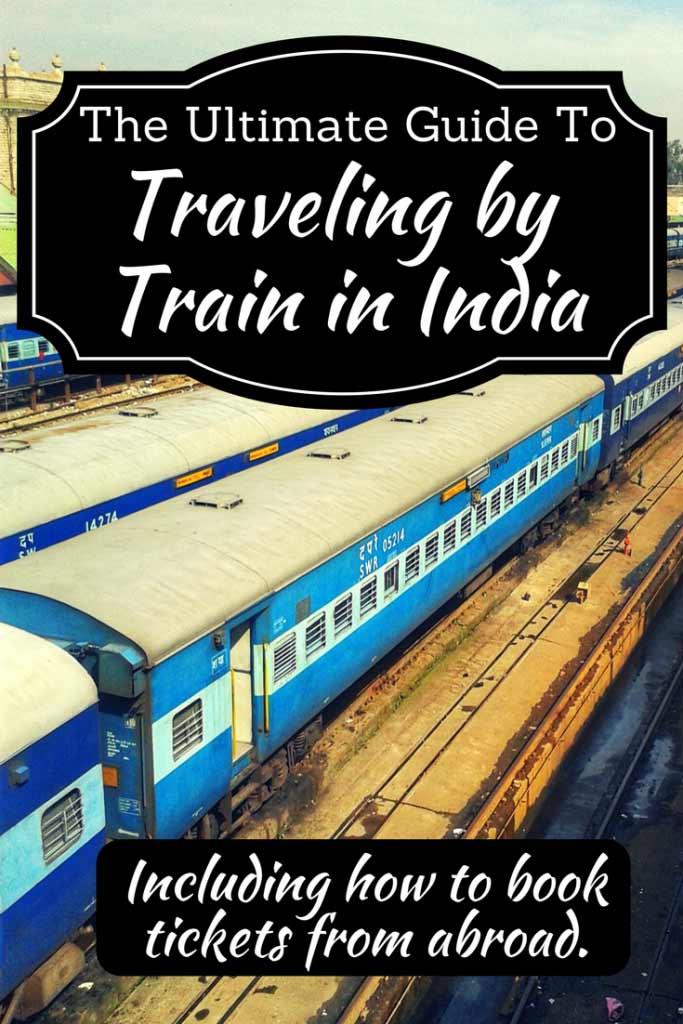
Indian Rail Travel Explained
India is a huge country with an amazing diversity of sights but vast distances mean that when planning a trip to India you need to give some thought about how you are going to get around.
India offers multiple ways to get around (albeit often slowly) this massive sub continent, you can get transport to pretty much every corner of India for a very affordable price, but you need patience because getting anywhere in India always takes longer than you think.
My main advice is always to take it slow – Everything seems to take a lot longer than you think and trying to cram too much in often leads to a stressful and frustrating trip that is hard to enjoy.
Read More: 5 Common mistakes travellers often make when visiting India for the 1st time
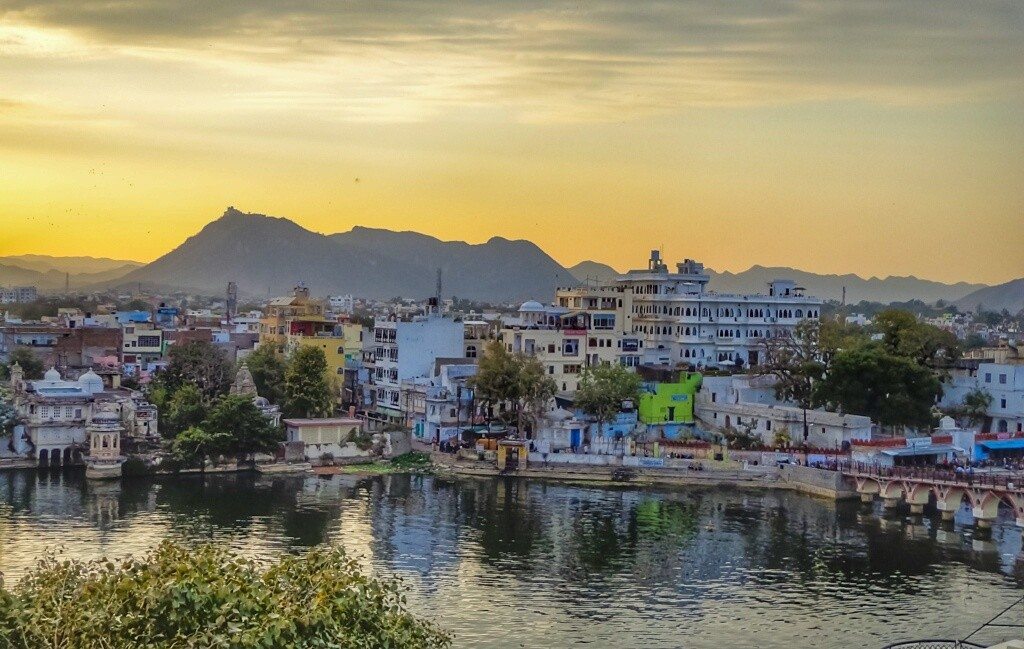
Why take the train instead of the bus?
Train travel is very popular because the roads in India are often poor, traffic can be chaotic and buses rickety so the best way to get around the huge and diverse country of India is by train.
Of course, you could take the bus – buses in India range from bone shakers that you can’t believe are still in one piece and running to ‘delux AC’ buses that are just about reasonably comfortable.
Still, taking the train is so much more comfortable in India and the scenery is usually better. After a nightmare sleeper bus ride ( it was like being in a coffin on a roller coaster) from Mumbai to Goa on my first trip to India I always prefer train travel in India now, especially on longer journeys.
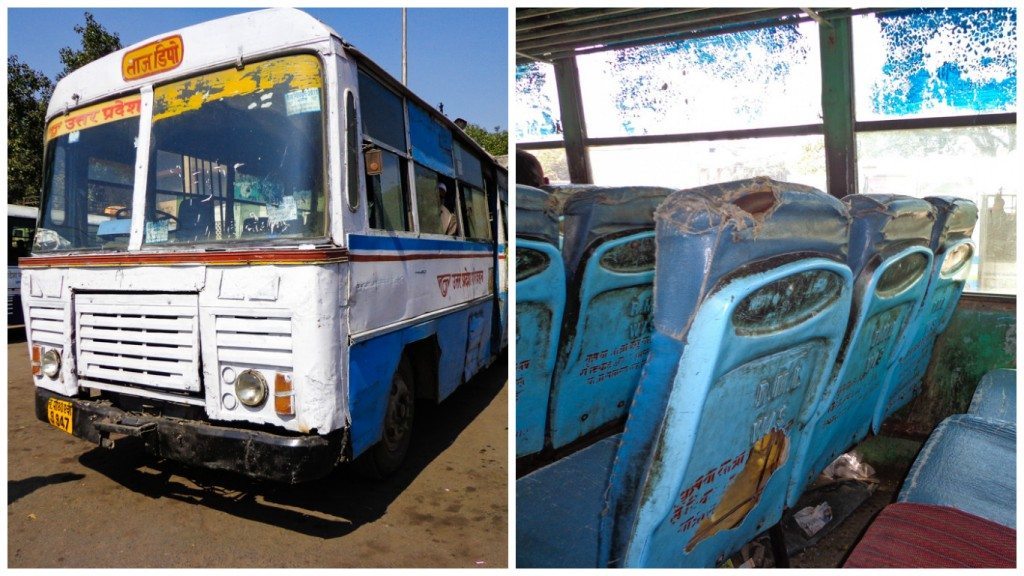
The Indian railways network is one of the largest in the world and stretches to almost every corner of this amazing and diverse country and ticket fares are incredibly good value. With over 63,000 km of rail routes and 6,800 stations you can get to pretty much every town or city in India by rail.
Indian Railways is the third biggest passenger rail network in the world (after Russia and China) and the busiest in terms of passengers. About 23 million people travel regularly by train in India and Indian Railways employs over 1.5 million staff making it one of the world’s biggest employers.
There are over 10,000 locomotives with over 67,ooo passenger coaches covering over 66,0o0 Kms across the country. If you laid out all the railway tracks in India in one straight line they would circle the earth about 1.5 times!
Indian train journeys don’t get boring, you’ll see all sorts going on both inside and outside the train and its a unique and culturally immersive experience that you won’t want to miss.
But in the world’s most densely populated country seats on Indian trains sell out fast, especially for popular routes in the peak tourist season you can find trains booked up weeks or even months ahead which could put a real delay on your travel plans! Which means arranging your train tickets should be on your ‘to do’ list as you prepare for your trip to India.
Read More India travel blogs:
- My Complete Guide to Planning your First Trip to India
- My complete guide to getting a tourist visa for India
How to book train tickets for Indian railways in advance?
As train travel in India is so popular I always advise people to book their train tickets in advance, there are many ways that you can book a train ticket in India but if you are expecting to be able to arrive and hop on and hop off then you will be disappointed.
You will need a reservation for all Indian Railways long distance trains, except if traveling in unreserved second class which I wouldn’t recommend (although it’s often not as bad as you this! …)

There are several ways that you can buy an Indian train ticket – online, at a travel agency or Indian Railways booking counter.
Update! You can now also book some (but not all routes are available) Indian Railway tickets online at Bookaway
Due to the high demand for train travel in India tickets for Indian trains can be booked up to 120 days in advance.
To make your trip to India more enjoyable and less stressful I recommend you book your tickets in advance, especially if you have a limited amount of time to spend traveling India and a packed itinerary of places you want to see.
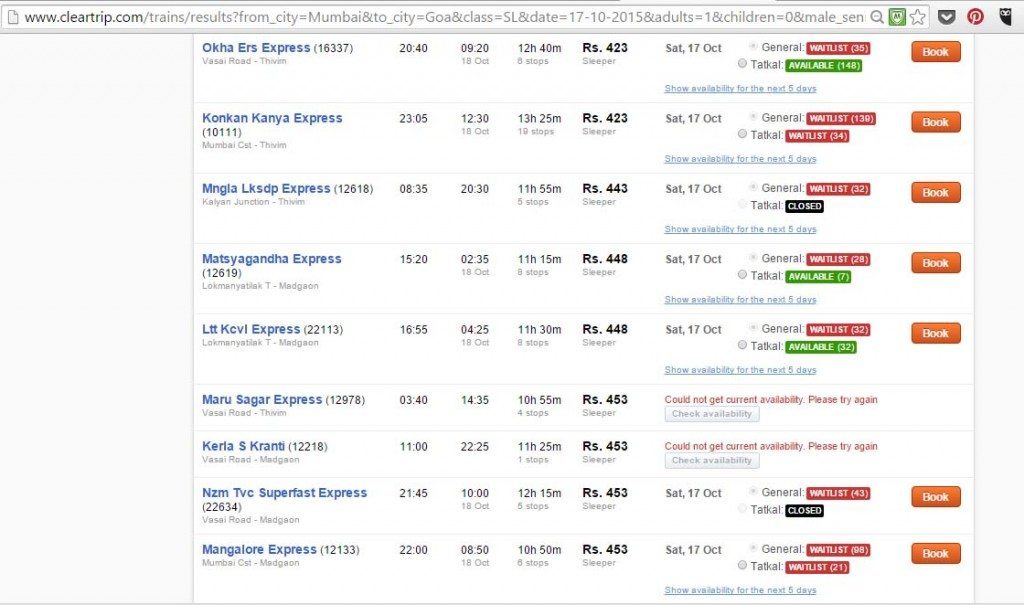
If you want to find out the earliest date that a train is available you can look on www.indianrail.gov.in and click ‘Availability at major stations’ then ‘Earliest date of available berths’ you can see the next date on which berths are available on key trains leaving each of the most important stations.
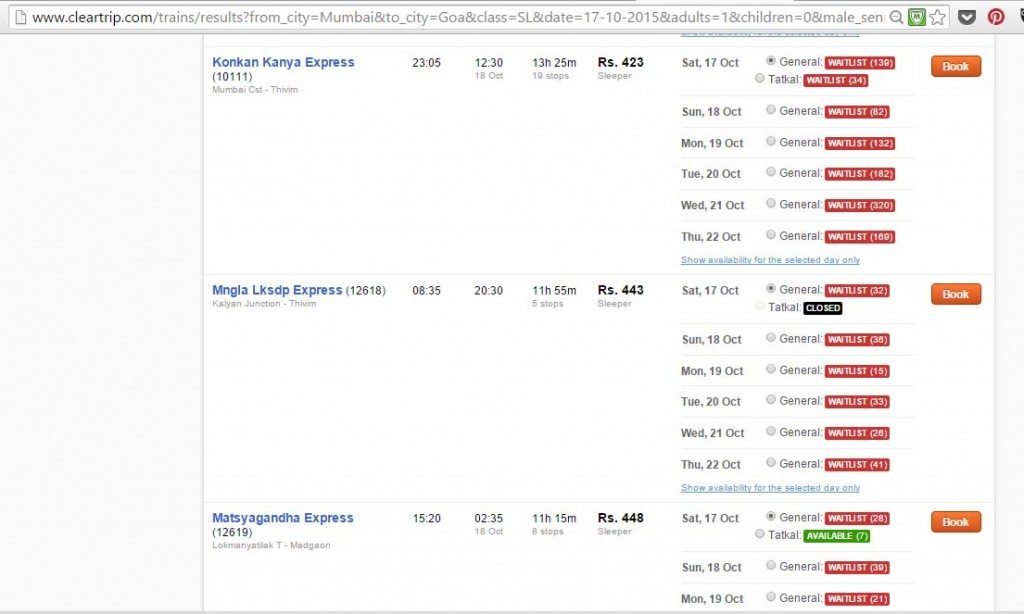
So now you can see why you need to book train tickets in advance! But booking trains from outside India is not so easy….
Where to book tickets for Indian trains:
Use a travel agent like India Someday
The easiest way by far to book train tickets from abroad is by using the services of a travel agent. India Someday are expert trip planners, and I’ve had great experiences travelling with them before so now I always use India Someday to book my train tickets. They charge a small service fee but it takes away all the hassle and stress of booking train tickets and ensure you get the right trains to make your trip run smoothly.
India Someday can also help with all aspect of planning a trip around India, advising on the best routes to take, accommodation and all transport options. Global Gallivanting readers can also get 5% off the trip planning fee by using the code GLOBALGALLIVANTING5 when enquiring. Contact them through their website.
IRCTC Website
Online reservations can be made on the official government IRCTC Online Passenger Reservation website. I don’t find the IRCTC website very user friendly. It is slow and temperamental – often the service is unavailable although sometimes if you keep trying it will work eventually.
It’s also not so simple to use – first you need to know the number of the train you want to book instead of being able to search and book by destination (and importantly checking availability) and it also does not accept most foreign cards and can be hassle to set up an account without an Indian mobile number.(see here how to get an Indian sim card)
Clear Trip
A much easier way to arrange your train travel in India and book trains, even from abroad, is to use a website like Cleartrip.com to search and book trains.
Their website is much more user friendly and easier to use. There is even an app you can get on your phone and, once your account is set up, this is probably the simplest way to book trains – it’s actually pretty easy once you get the hang of it!
Most importantly you can pay with an international card. However they do charge a small service fee and not all trains are displayed, you can now book Taktal tickets online but you can’t book the Foreign Tourist Quota through these websites.
How to set up a Clear Trip Account
To set up a Clear Trip account IRCTC has insisted that you must also sign up for an IRCTC account. When you register with Clear Trip it will set both accounts up for you, but IRCTC requires an Indian mobile phone number.
This makes it a little difficult to set up the account before you arrive in India but it is possible – you can set up a Clear Trip account before you arrive without an Indian mobile number but, as with most things in India, patience and persistence are required.
Read More: How to get a local sim card in India
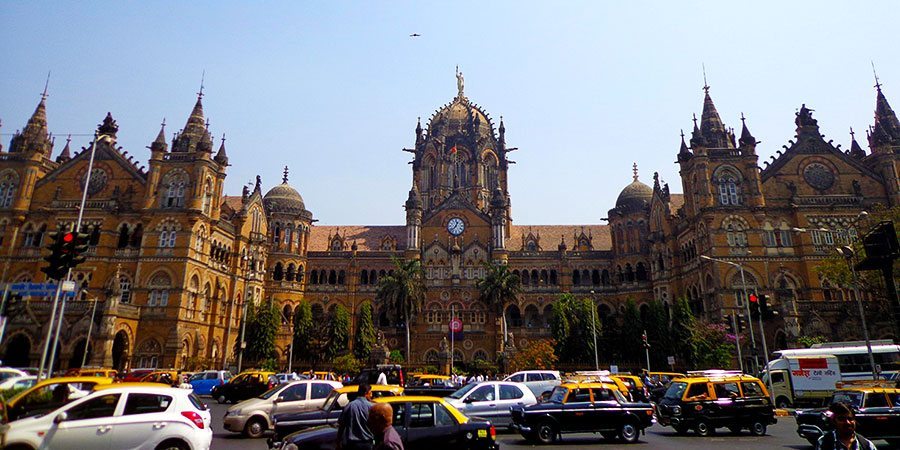
Read More: My Mumbai Travel Guide: The best places to visit, stay and eat.
To set up a Clear Trip account go through the normal process to set up an account, where it asks you to enter an Indian mobile number and zip code you will need to just make these up.
To make up an Indian mobile number it’s 10 digits and usually starts with 9, but you can’t use a mobile number that has already been used before so you might have to try a few combinations.
Then make up a numerical zip code (doesn’t work if you put in a UK style postcode) but make sure you change your country from India to UK or US or wherever and then finish the registration.
Then you should get an confirmation email with an Email OTP (Email One Time Password). Now send an email back to IRCTC customer care, attach a scan of your passport, quote your IRCTC user name and ask them to send you the SMS OTP by email.
It could take a few days or you may have to chase them for a while. Once you get the password then you can verify and activate your account on Clear Trip and enter the Email or SMS OTP and then you are ready to book train tickets and enjoy train travel in India!
There is more detailed information of this process on the really useful website – the Man in Seat 61
It’s a bit annoying but train travel in India really is the best way to travel here and so it’s worth it to book in advance and avoid the hassles of trying to get train tickets once you arrive.
Once you’ve got your Clear Trip account set up and the app on your phone it’s actually pretty easy to book train tickets! Just search the trains on the route you want to go, check the availability of the trains and book. Your ticket details will also be saved on the app and you can show it to the conductor – this is how I book most of my train travel in India.
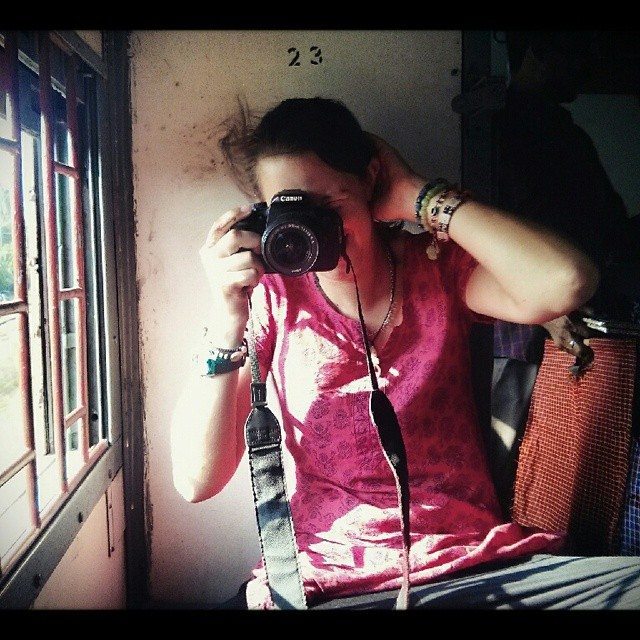
Use a travel agency or ask a friend
If you have a friend in India you could ask them to book the train tickets for you and forward you the ticket by email. If not, if you want to avoid hassle and don’t mind paying a bit more you could ask a reputable travel agency or a train travel specialist to sort out your train bookings.
I recently traveled through North India for 12 days and used a great company called India Someday to help plan my itinerary and book trains and homestays along the way (read about it here)
India Someday are a young, energetic and resourceful travel company based in Mumbai (Bombay) who are experts on India and can assist you in booking trains and other transport as part of planning a complete well thought out, personalized trip to India.
They even offer Global Gallivanting readers 5% off just use the code GLOBALGALLIVANTING5. Contact them through the India Someday website.
Read More: My review of traveling with India Someday
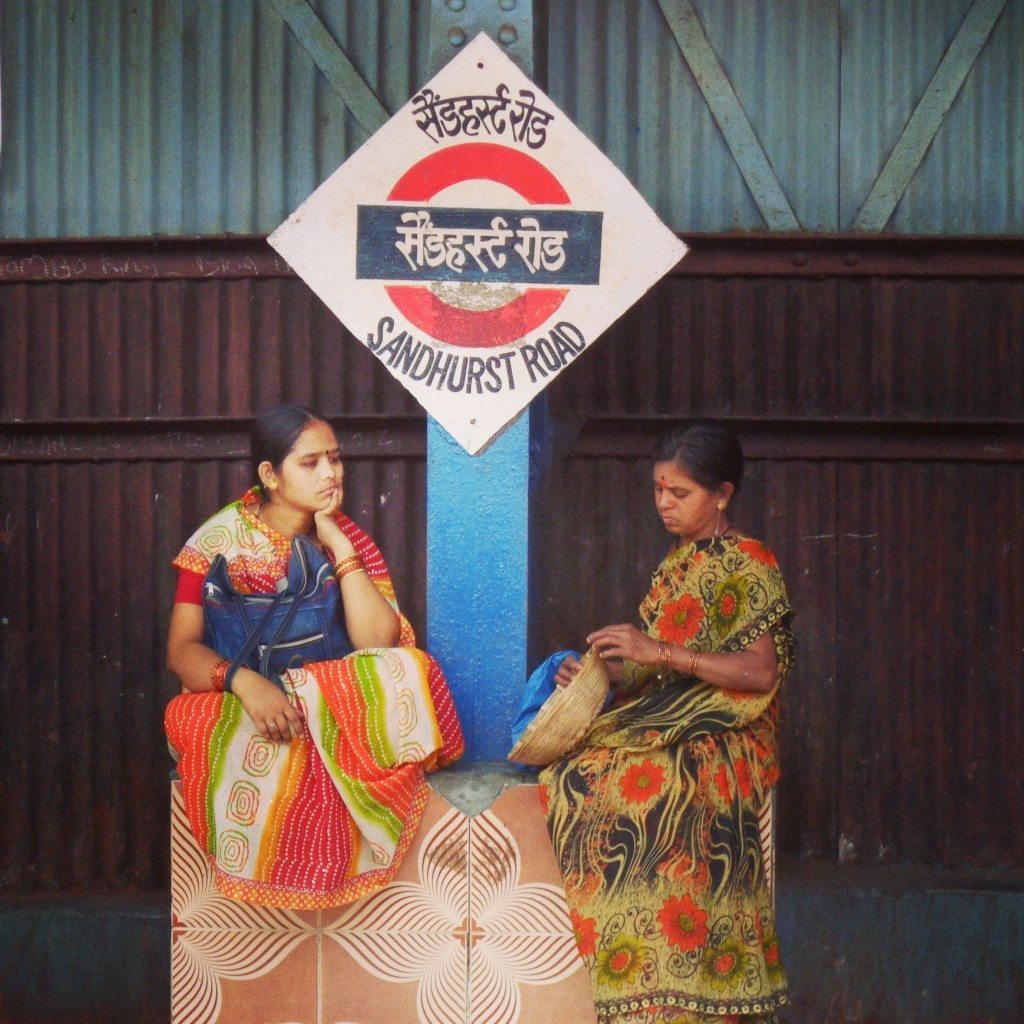
Read More: Tips for women traveling in India
If you prefer your train travel in India to be more luxurious then there are even some ultra luxury tourist train routes in India, escorted group trips by train and rail passes.
There is an IndRail Pass option where you can buy the pass and ask them to make all the reservations you want to go with it, free of charge.
However, I’ve never tried this as I prefer to stay flexible and travel slow. Using a rail pass would most likely be more expensive than booking point to point tickets and to get your money’s worth you would have to have quite rushed and busy itinerary that was all pre booked. I
f you only had a short time to explore India and wanted to have everything pre arranged then this might be an option.
Read More: The perfect route and itinerary for backpacking India
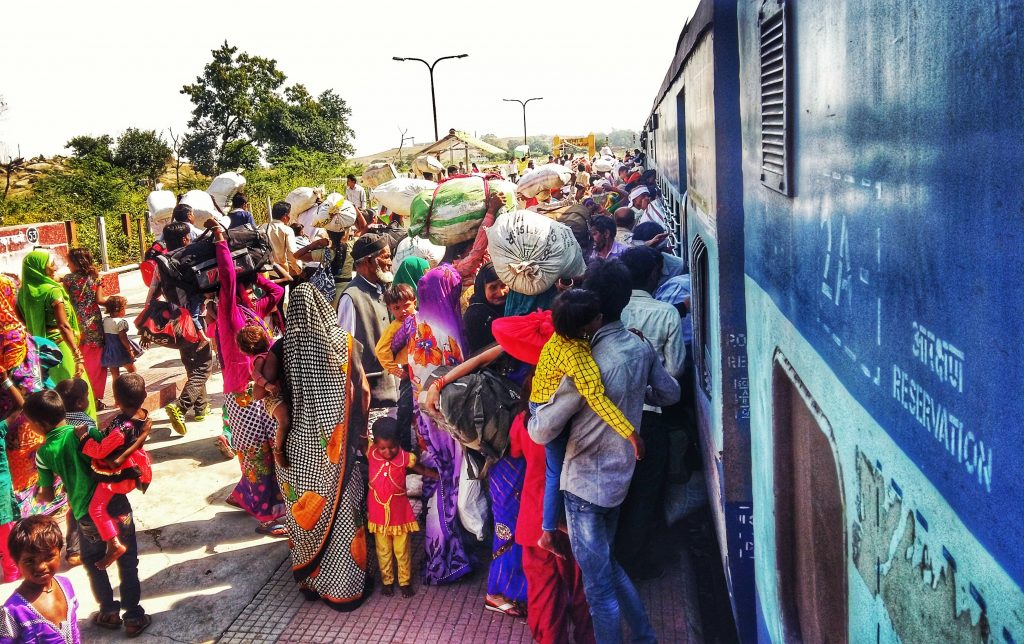
Tips for booking train tickets in India
Train travel in India, like everything else in India, always throws up some surprises, here are a few more tips and things you should be aware of when traveling by train in India.
Whether you use IRCTC or an app like Clear Trip the Indian railways online booking service closes for maintenance each day between 23:30-00:30 Indian time ( 18:00-19:00 GMT)
Sometimes the system is overloaded with visitors or just randomly won’t work, shows an error or no trains available – as with everything in India be patient and persistent, refresh the screen and keep trying and it should work in the end!
The system only shows direct train routes. If your search does not come with any train then maybe it is because there is not a direct train to your destination the system cannot calculate a journey where you have to change trains, you have to find a station where you can change and make the booking separately as 2 tickets.
Most places in India have 2 names– the old colonial names and the newer more ‘Indianised’ names. If you are having trouble with the destination try the other spelling! Usually it uses the Indian name but sometimes, for example Trivandrum is still used instead of Thiruvananthapuram, Bengaluru uses the old name Bangalore.
Also, sometimes the name of the railway station is not necessarily the same name of the city. For example, the main railway station (and one of the busiest) in Kolkata/Calcutta is called Howrah so you would need to type this in.
Also, many major cities have more than one train station – a search for trains from Mumbai will bring up stations like Lokmanya Tilak, Navi Mumbai or Thane which are actually pretty far away from the main re where travelers stay.
The main station in Mumbai is CST, in Delhi the main station is New Delhi, but there are also many others. For Goa, the main train station is Madgaon/ Margao.
For stress free train travel in India and to book trains you will need to first have a little geographical knowledge of India, to help you you can can check the Indian Railways Trains at a Glance timetable.
Read More: 8 useful apps to make traveling by train in India easier
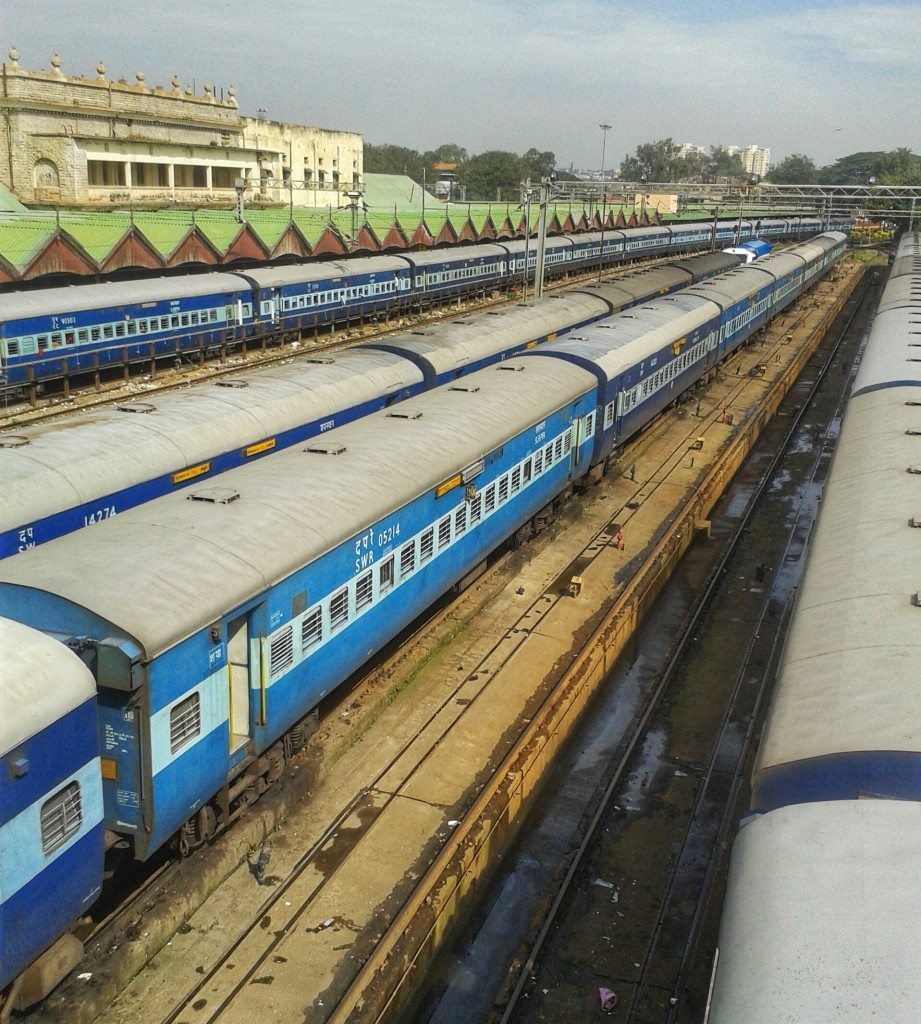
How to get a train ticket at the station in India
The main stations in big cities and tourist centres, such as New Delhi, Mumbai, Calcutta, Agra, Jaipur and Varanasi (and 24hrs at Delhi International Airport) have a separate booking office for foreign travellers called an International Tourist Bureau that you will need to visit if you want to get a last minute ticket from the foreign tourist quota.
Make sure you bring your passport, visa and cash and make sure you go to the right one! Don’t believe anyone that comes up to you claiming that it has closed, moved, burnt down, all trains are cancelled or whatever else! This is a scam to get you to go to their travel agency which may or may not even be able to provide the services but will certainly over charge you!
There is a list of stations with an International Tourist Bureau at www.indianrail.gov.in under the Information and International Tourist tabs. You could try your luck at a smaller station that has an international tourist reservation bureau as it may be less hassle and less waiting.
Either way, to apply for a tourist quota ticket you cannot get these online, you will need to go in, fill out a form showing where you want to go, show your passport and visa, wait and hope that there is a ticket available in the next couple of days for where you want to travel to.
You can only pay in cash with US dollars, UK pounds, Euros, or Indian rupees and you may need to show an encashment certificate, ATM receipt or something that shows that you obtained this cash in a proper, legal way.
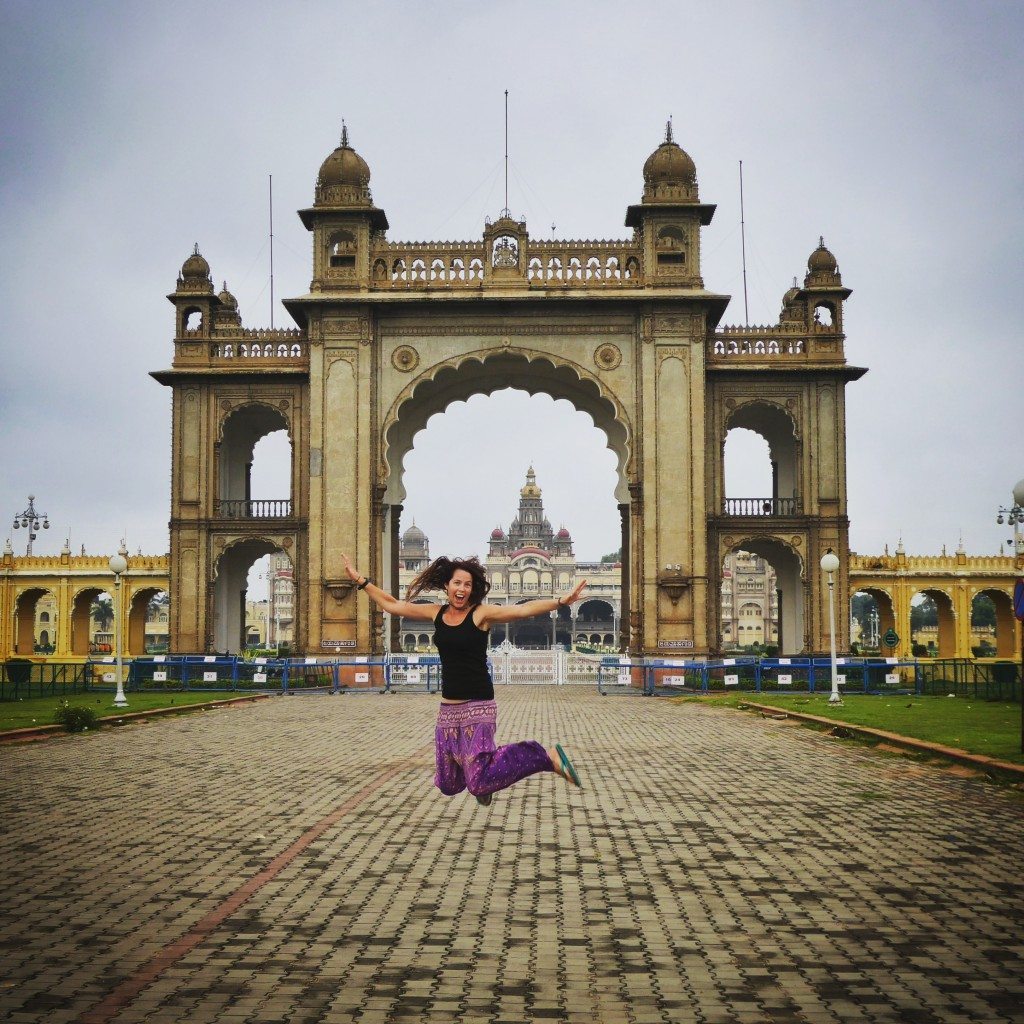
Read More: My Mysore Travel Guide: The best places to visit, stay and eat
So now you know how to book your ticket, read on to know which class to book…
Indian Railway Classes Explained
When you are booking train tickets in India, first you will need to understand what class you want to travel and what type of ticket you have.
The array of 8 classes on Indian trains can seem bewildering at first, although only a selection of these classes will be available on any given train, but let me break it down for you:
(AC1 or 1A) – Air conditioned first class
These can be sleepers or executive chair class and are a comfortable way to travel with lockable compartments in 2 or 4 berths available. However, there are not many carriages of these class and they are not found on every train. Also, the price is double the cost of AC2 and often comparable to a domestic flight.
Example price from Mumbai to Goa – Rs 2,640 ( £26 / US$40 )
(AC2 or 2A) – Air conditioned 2-tier
AC2 is a comfortable and relatively clean way to travel and favoured by most middle class families. AC carriages (and the non air conditioned sleeper carriages) with upper, middle and lower bunks arranged in bays of six on one side of the aisle, and along the coach wall in bays of two (upper and lower) on the other side of the aisle. The bench style padded seats convert into bunks at night.
In the AC carriages, pillows, sheets and blankets are provided for overnight journeys and you also get plug sockets. On AC trains the windows are sealed and tinted this means not so much dust gets in so they are cleaner than sleeper class but the windows are often quite dirty so not good for gazing out at the countryside or taking photos. It’s also a good idea to take a fleece or jumper for the AC carriages too as sometimes I find these too cold.
The main difference between AC2 and AC3 is that there are only 2 levels of bunks instead of 3, so it feels a bit less crowded, and that AC2 has individual berth lights curtains allowing for a bit of privacy.
Example price from Mumbai to Goa – Rs 1,580 ( £15 / US$ 25 )
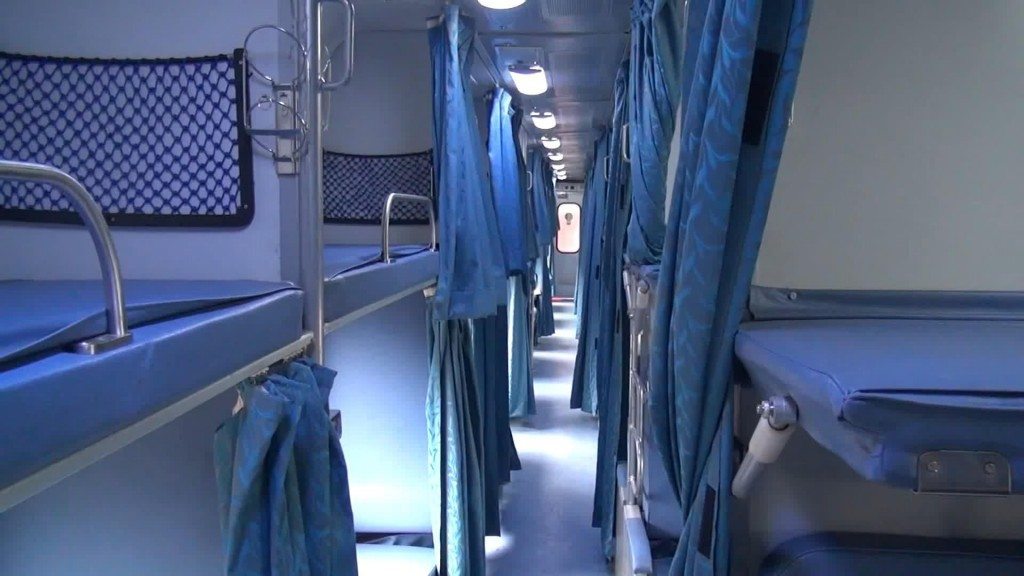
(AC3 or 3A)- Air conditioned 3-tier
AC3 is very similar to AC2 with an open plan and air conditioned carriage with three tiers of bunks instead of 2 and is slightly cheaper. Bedding and plug sockets are provided and the windows are sealed but there are no privacy curtains. Normally the AC carriages are a bit cleaner and the berths are better padded than in sleeper class.
Example price from Mumbai to Goa – Rs 1,120 ( £11 / US$ 17 )
(SL) Sleeper Class
Sleeper class coaches make up the majority of carriages on most long distance Indian trains and this is how most Indians travel.
The bunks are similar to those mentioned before in the AC carriages expect that, instead of air conditioning, there are fans and the windows are open providing a cool breeze and a good view of the countryside that’s better for taking photos!
The windows are fitted with bars to keep out intruders and have shutters you can bring down if it rains. There is also no bedding provided and it’s pretty grubby so you will probably want to bring your own sheet or sleeping bag.
When traveling in the winter (the best time to travel in India) I find that I don’t need air conditioning – actually the AC is often too cold for me and the temperature in sleeper class once the train is moving is not too hot (actually sometimes in the North it can be a bit chilly)

Read More: Tips for women traveling in India
I usually use sleeper class in the winter although I do prefer to take an AC carriage in the hotter months or if I’m traveling alone on a long journey over night.
Riding the rails is an essential experience for anyone visiting India and the atmosphere in sleeper class is always more vibrant. You will often find that families want to talk to you and share their food with you. There are also hawkers coming along the train all the time selling food, drinks and a whole array of other items to the background soundtrack of tinny Bollywood tunes played from mobile phones, the rhythmic clack clack of the rails and the cries of “chai, chai, chai , coffee, coffee, coffee.” You can also buy food from the stations as sellers can pass it through the windows to you.
As all berths have to have a reservation the carriage should not be too crowded but sometimes people do still try their luck and the open windows do mean more noise and dust comes into the carriage but traveling in sleeper class gives you a better insight into Indian life both on and off the train.
Example price from Mumbai to Goa – Rs 420 ( £ 4 / US$ 6 )
Read More: 30 Incredible experiences you can only have in India!
You might also find:
(EC) – AC Executive chair class and (CC) AC Chair class
These classes are a comfortable and air conditioned good choice for day time journeys. There are also newer, modern fast trains like the Rajdhani Express (long distance) and Shatabi Express (day time) on important routes for example Delhi to Mumbai that are very comfortable and faster than the older, normal trains. Food and drinks are sometimes included in the fare and served at your seat.
Example price from Mumbai to Goa – Rs 950 ( £ 9 / US$ 14 )
First class (FC)
The traditional non-air-con 1st class coaches with lockable compartments but these are quite rare now.
(2S) Second Class Sitting
Open plan and non air conditioned cars with wooden or padded plastic seats. Fine for shorter day time journeys and most seats can be reserved but there are usually a couple of carriages like this that don’t need a reservation although I wouldn’t recommend joining the scrum in the unreserved carriages.
Example price from Mumbai to Goa – Rs 250 ( £2.50 / US$ 3.80)
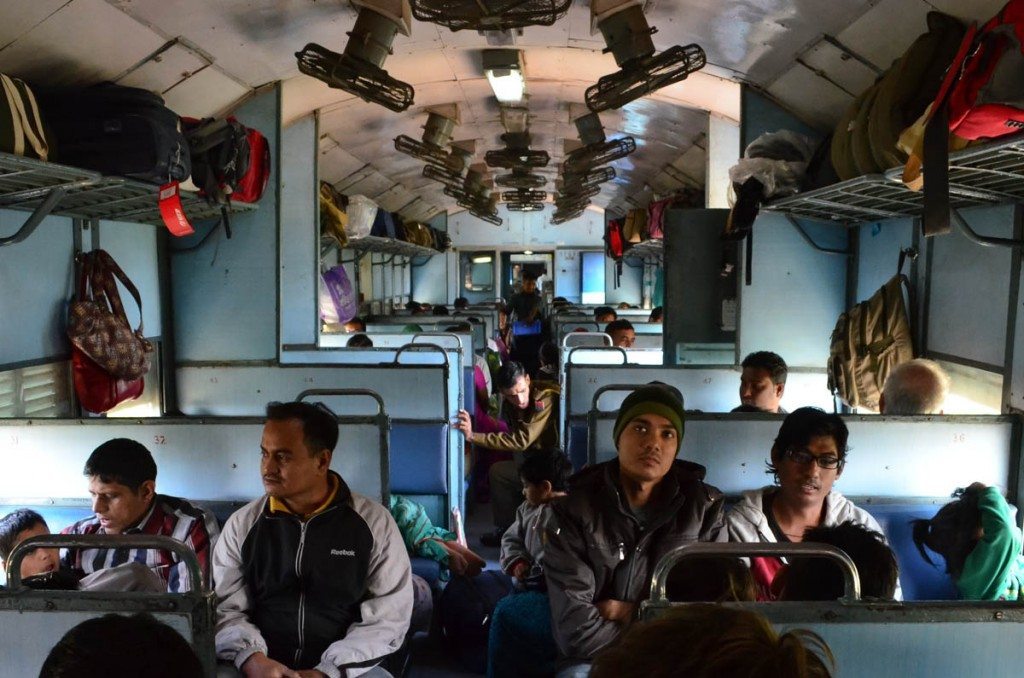
Luxury, Shatabdi and Rajdhani Express Trains
If you are traveling shorter distances between major metro cities, popular tourist destinations or important pilgrimage sites you could book a seat on one of the newer and faster air conditioned Shatabdi or Rajdhani express trains.
There are only 2 classes and only seats not sleepers and the trains do not stop at so many places and the price is higher but these trains will get you where you need to go quicker and more comfortably. Refreshments are also often served on the train and are included in the price.
There is a new high speed train that connects New Delhi to Agra for the Taj Mahal in only 99 mins. Read more here The Delhi-Bhopal Shatabdi Express takes 126 minutes to reach Agra from Delhi.
There are also new ultra luxury train tours you can take in India like The Deccan Express – the most luxurious train in India
There is also a new modern double decker train called the Tejas Express that has just started traveling the Mumbai – Goa route. Read more here…
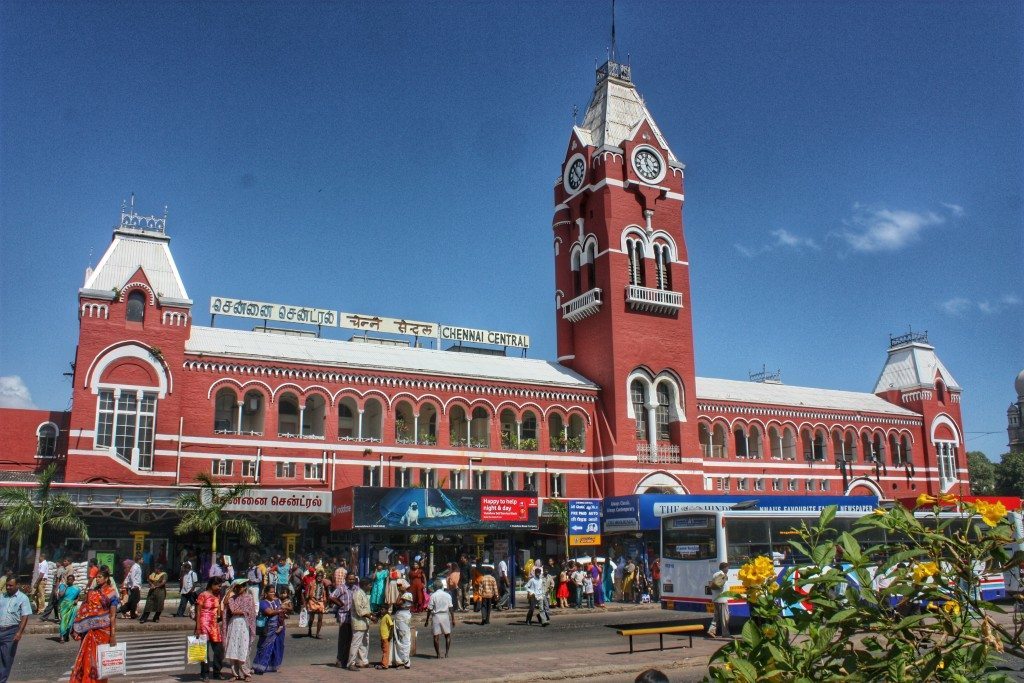
Indian Train tickets explained
So once you’ve decided which class of carriage is most suitable for you, you can book your ticket. Like the classes, there is also a bewildering array ticket types for Indian trains.
Here is an explanation to the ticket types and acronyms that you will find when booking train tickets in India:
CNF
As train seats often get booked up far in advance if you see availability then book it while you can! Don’t wait and come back to it in a few days it may be gone and you can always cancel if you change your mind!
If your ticket says CNF then congratulations! You have a confirmed seat on a train!
RAC (Reservation Against Cancellation) and Waitlist (WL) tickets
Once a train is fully booked with confirmed reservations (CNF) next tickets are sold as ‘Reservation Against Cancellation’ (RAC) and then after that passengers are put on the Waitlist.
If you have an RAC ticket, you are allowed to travel on that train you just don’t have a specific seat booked until someone cancels and then you are promoted from RAC to CNF (confirmed). If no one cancels you can still get on the train and you should be given somewhere to sit but maybe not a sleeping berth.
If you are on the waiting list you still have to pay for your ticket but unless you are promoted to RAC or CNF before departure you are not allowed to travel. If you are not promoted to a confirmed seat then your fare will be refunded.

Read More: The Ultimate Guide to Goa
Sounds risky but I’ve done this many time with a waiting list of 15 – 20 or below and always got on the train. You will find that 24 hours before the train is due to depart many people cancel and you should get a text/ email saying that your ticket is confirmed and showing your seat number.
I’ve seen waitlists of over 300 but I wouldn’t bother to join them but I take an RAC or WL ticket under 20 and have a good track record of getting a confirmed ticket.
You can check the status of your booking on www.indianrail.gov.in/pnr_Enq.html or if you booked with Clear Trip enter the PNR number on your booking. If you have the Clear Trip app you can also check PNR status on there and any movement should be sent to you in a text. Don’t give up hope too soon if you are on the waitlist – most of the movement happens the day before departure.
With both of these options there is no guarantee that you will get seats together with your travel companions although it is likely that a family will all cancel together therefore giving you their seats together.
Tatkal (CK) Quotas
Tatkal is Hindi for immediate. There some tickets on key trains that are held back for emergencies and available to book one day before departure and sold with an extra charge. For trains where there is no tourist quota you could try booking at Tatkal ticket. You can book these online from 10am one day before the departure but as the website is temperamental it’s best to go in and try to make the booking.
With Cleartrip you can book tickets from the General quota and the Tatkal quota for travel the following day but you cannot book Foreign Tourist quota tickets. You can also cannot buy more than 10 tickets per month. You cannot amend or change a booking but you can cancel it online and you get the majority of the ticket price refunded.

Tourist Quota Tickets
On many popular trains there’s a special (but small) Foreign Tourist quota which gives foreigners a chance to get on a train! The tourist quota is not available on every train and there are only a couple of tickets available. So hoping for tourist quota tickets can be risky, if you know your itinerary then it’s much better to book your trains in advance.
With tourist quota tickets you will probably still have to wait a couple of days, it does not guarantee a seat on a train and cannot be booked online meaning you have to go and wait around at the ticket booking office (possibly for a few hours) and hope you can get on a train. Tourist quota tickets can be paid for in US Dollars, pounds sterling, or rupees but you may need to show an exchange certificate or ATM receipt.
Read More: 7 Reasons why traveling in India isn’t as difficult as you might think
More Tips for traveling India by train
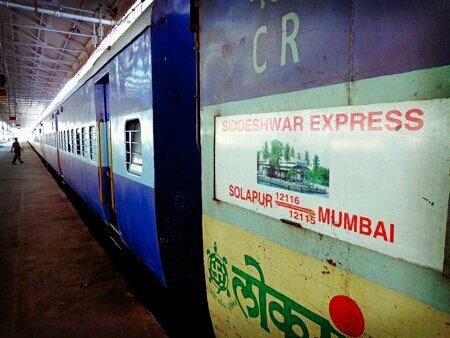
Arrive with good time at the station to find your platform and seat.
Indian train stations can be huge, chaotic places and departure platforms can sometimes change at the last minute so arrive at the train station with plenty of time to find your train.
Your train, coach and berth number will be printed on your ticket and you can check the train number on a board to find out the platform.
Announcements are made in Hindi, English and the local language and reservation lists are posted on the notice board at each station and on the train door too and you can check your name is listed.
Indian trains are also really long, on the platform are markers to show where each train carriage should arrive and each carriage is also labelled.
Your carriage number and seat number is on your ticket for example S6 means the 6th carriage in sleeper class. B1 is the 1st AC3 carriage, A1 is the first AC2 and H1 would be first class AC. Usually the higher classes are at the front of the train don’t leave yourself sprinting down the platform trying to find your carriage with your backpack on.
Once on the train you won’t be able to cross between carriages of different classes so you would have to wait until the next station if you got on in the wrong class.
Showing your ticket
When traveling by train in India all passengers are required to show their ticket and passport to the train conductor. Tickets cannot be sent overseas or picked up at the station but Cleartrip issues e-tickets, emailed to you to download and you can also see your tickets in the ‘Trips’ section of the app.
Until recently it was necessary to physically print out the tickets (annoying!) but since Feb 2015 I’ve had no problems simply showing the conductor the booking made on my phone in the app or downloaded email ticket along with my passport.
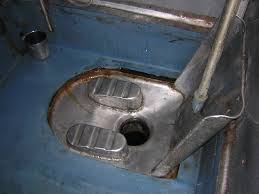
Toilets on Indian Trains
One of the biggest concerns about train travel in India is the toilets! Going to the toilet on any train is never the most pleasant experience and on Indian railways it is not different. There are toilets and wash basins at the end of every carriage with both squat and western options. Neither of which are that clean but not totally unbearable.
There is usually no toilet paper, soap or water but most travellers in India take tissues and hand sanitizer everywhere with them. Be careful you don’t drop anything out of your pocket onto the track too! I haven’t travelled in 1st class but found that the conditions or the toilets in the AC classes are not that much better than sleeper class.
Food and Drink on Indian Trains
Indian Railways do not always have buffet or restaurant cars on the trains but some sort of food is always available. Hawkers regularly pass through the cars selling all kinds of food and drinks among other things for a few rupees (keep lots of 10 rupee notes handy for train journeys as they often don’t have change and most things are 10 or 20 rupees)
You can also order food from the attendant (veg or non veg) and it will be served to your seat. It’s cheap but I often find the train food is not great and the hygiene can be suspect so I often prefer to take snacks on with me.
There are also often many hawkers at the stations selling food, some stations even have local specialties, sometimes you can even call a restaurant and ask them to deliver to the train – Dominos is even staring to deliver pizzas to trains!
Expect to be late
I joke that Indian Railways must have an unbroken record of never having a train arrive on time but seriously I’ve never been on one that arrives on time so I allow plenty of time for delays. Time is a more flexible concept in India! Allow extra time for your train to be delayed by a couple of hours and chill out – India will teach you to be more patient and you will get there eventually!
The further the train is from the source (the start) the more likely it is to be late. These trains travel over many days all across the country so it’s no surprise that they often get held back. You can check the train running status online if your train will be late at www.trainenquiry.com or look on www.erail.in enter the train number to see how late yesterday’s train arrived to get an idea.
Also be aware that train travel in India can take a long time, India is a huge country and most of the trains travel pretty slowly and stop a lot – the journey from Kerala (Trivandrum) to Delhi could take over 50 hours – that’s over 2 full days (and maybe more if it is delayed) Domestic flights are not cheap but could be an option if you don’t want to spend 2 days on a train! I use Skyscanner to check for the cheapest deals if I need to save time.

How safe are Indian trains?
Train travel in India is one of the safer ways to travel however there are accidents on Indian Railways, the network is huge, aging and derailments do happen, although there has been a big drop in serious incidents since in the early 1990s and traveling by train is still safer than traveling by road!
Apart from accidents, train travel in India is usually pretty safe even for women travelling alone. In the lower classes you may encounter many stares of attention from other passengers but most of the time they are just curious. Foreigners traveling in the higher classes attract less attention and may feel safer because the other passengers are generally more educated but overall you are unlikely to have any problems at all.
On overnight train journeys women should book the upper bunk to avoid any potential wandering hands and also you can go and sleep without having to wait for other passengers to want to sleep. Women should take advantage of the special ladies carriages wherever available (usually on local commuter trains) and take advantage of ladies queues and of course, dress conservatively. If I travel on my own overnight I prefer to go for a higher class and book an AC carriage rather than a sleeper one but generally trains are pretty safe. See more tips for women traveling in India here.
Take care of your luggage though, theft is not common but it can happen if the opportunity is there although I’ve never had any problems. It’s good to sleep with your valuables on you, perhaps in a money belt. You can also chain your bags underneath the seats so they are not easy to grab and run off with when the train reaches a station although this has never happened to me or anyone I know.
Read More: Tips for women traveling in India

Scams and Hassles on Indian trains to be aware of
Unfortunately India has more than it’s fair share of scams and hassle for a traveller to contend and train travel in India is not without its share of scams but you should soon get to realise who is genuine and just ignore touts, hawkers and other scammers. When you disembark after a long train journey in a new destination you are at your most vulnerable and will most likely to accosted with many offers of taxis, tours and hotels.
I always try to get a train that arrives in daylight wherever possible because I feel safer when dealing with these touts and of course it’s easier to find accommodation. Most of these offers will be over priced or a commission racket. The best way to deal with these is to just ignore all the touts and anyone that comes up to you, don’t engage at all and keep on walking confidently to find the official pre paid taxi or rickshaw stand (most big stations have them)
Failing that get out of the vicinity of the train station and just hail down a regular rickshaw who is just going about his normal business instead of preying on tourists and you are more likely to get a decent price and get taken straight to your hotel. It’s a good idea to know a landmark near your accommodation as more often than not the rickshaw driver will not know where it is although he may stop and ask people on the street as he goes along to help him find the place.
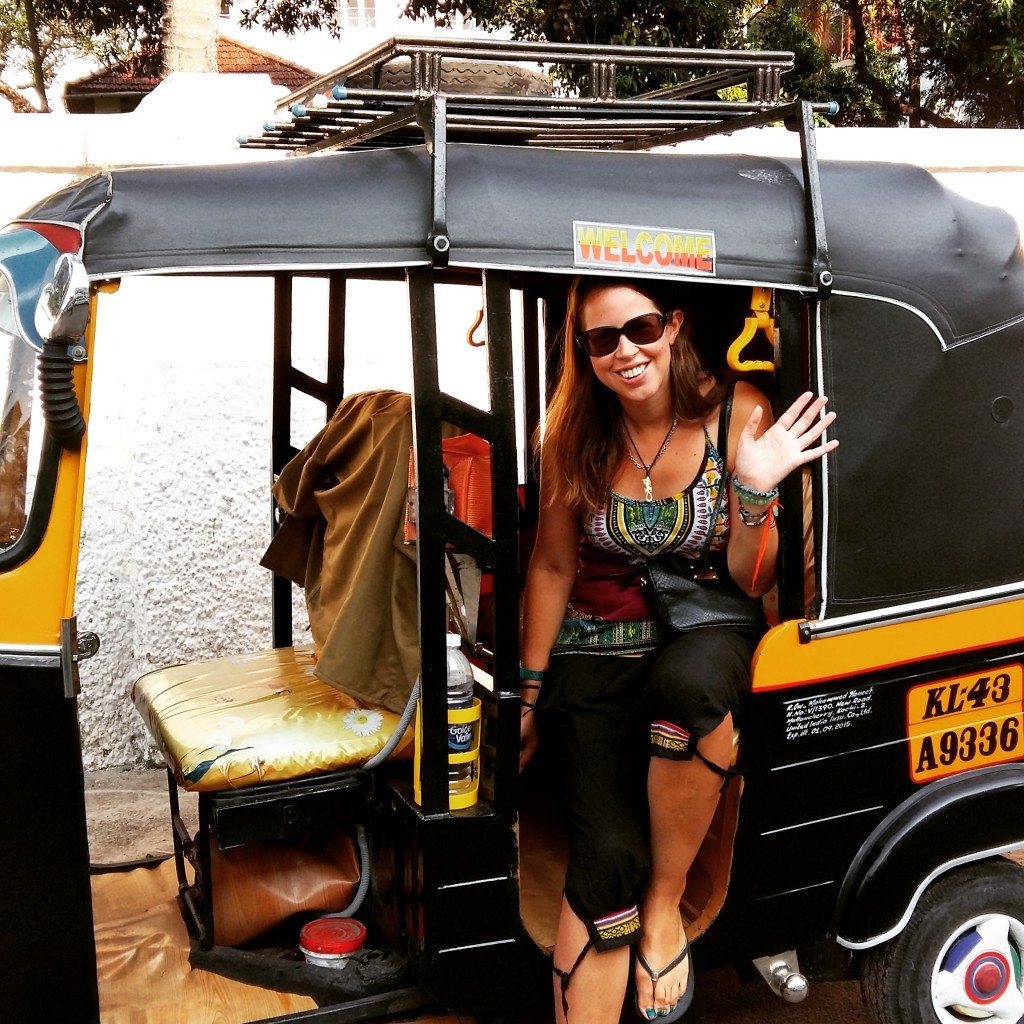
Read More: How to avoid the scams and survive your first time in Delhi.
Also be wary of anyone around places like train and bus stations, airport and major tourist attractions who tell you that where you want to go is closed, moved, burnt down, your train is cancelled or the hotel you want to go to is disgusting, closed, unsafe and that they will help you find an alternative or take you to the tourist information centre or ticket office.
Even if they look ‘official’ and are in uniform (this happened to me and I got scammed in Delhi ) or you will lend up being taken to an alternative hotel from which they will earn a commission or at some fictitious travel agency or tourist information centre paying a lot of money for a service that may not even exist. I’ve heard of people booking and paying for a whole 2 week tour that turns out to not exist or paying over the odds for a taxi all the way to Varanasi when it was just that the train was delayed. Read more about common scams in India.
Suburban Trains and Metros
Everyone’s seen those images of famously overcrowded Indian trains with people sitting on the roof and hanging on the side but I’ve never seen anything like that. Riding on the roof is illegal and I’ve never seen anyone doing it, the suburban trains or basic unreserved 2nd class carriages can get busy especially at peak periods, in Mumbai it’s called super dense crush load!
I avoid traveling in those peak hours on local trains but as long as your quick and prepared to barge on a bit taking the local commuter trains in Mumbai can be fun and a cheap and efficient way of getting around the crowded, congested and buzzing city.
Train travel in India is constantly changing and improving. India is rapidly building and introducing metro and rapid transit rail systems in many cities. Delhi’s metro is impressive, Calcutta has had one since 1984 and more metros are also started to operate in Bangalore, Mumbai, Chennai, Kochi and Jaipur.
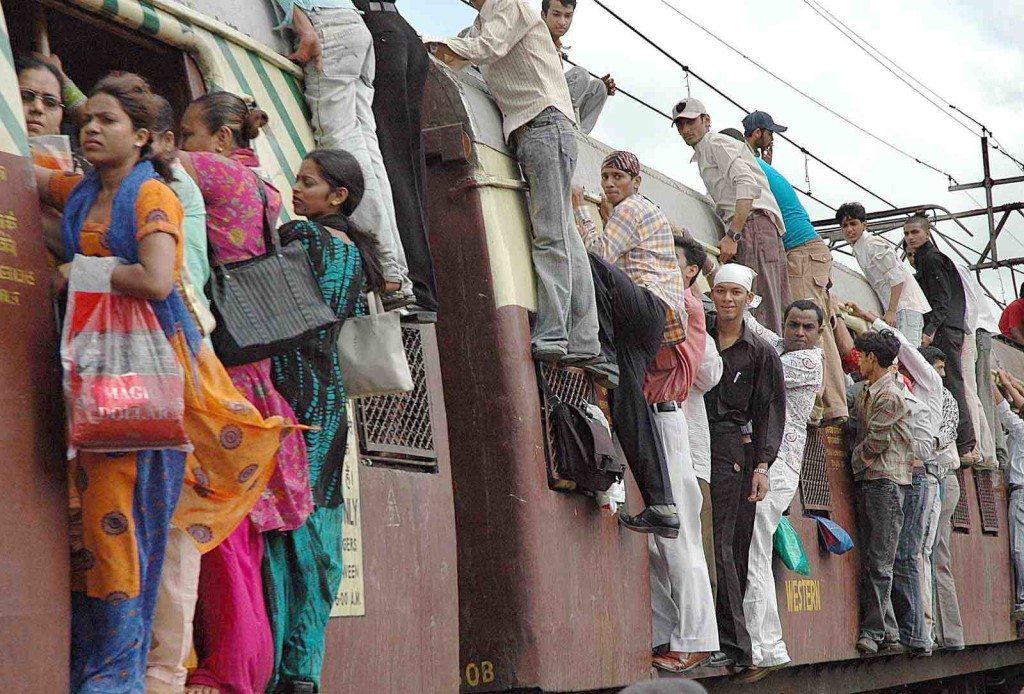
What if you like to be flexible and spontaneous?
I hear you! I do as well – I don’t like to have all my travels planed out as you never know what’s going to happen, who you will met, which places you will love and wish to linger longer in and which you will hate and want to leave asap.
You cannot change or amend your booking online though so what I do, as sleeper trains are so cheap, I often book a couple of options and then cancel the ones I don’t want only losing a tiny bit of money but it allows me to be more flexible.
It’s easy to cancel trains on the Clear Trip app and get a refund up to 4 hours before departure (not a full refund but you get most of it back).
Read More: The perfect route and itinerary for traveling India
Do you have any more questions or tips for train travel in India? Leave a comment below
Pin me and help another traveller 🙂

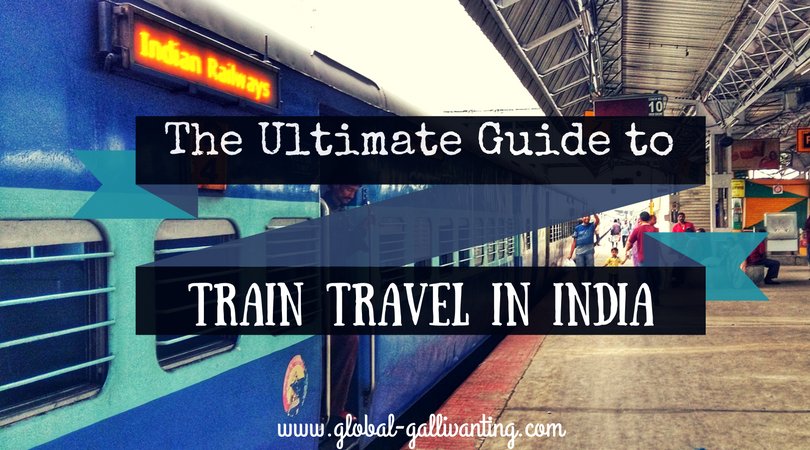
27 comments
Yes please..would be very helpful..as I would like to book train tickets from South Africa.
That would be very helpful please
PDF would be fab 🙂
Super helpful!
I like how thorough many of your articles are. This is helpful not just to foreigners but also Indians.
Thanks so much – glad to hear that! 🙂
Cool, glad its helpful – I will work on making it into a downloadable PDF 🙂
Can we get India train tickets from you?
From me? No, I’m not a travel agent so I can’t use my account to book for other people sorry.
The easiest way is to ask http://www.indiasomeday.com they can book train tickets for you for a small commission. I’ve travelled with them before see more here – http://www.global-gallivanting.com/my-review-of-traveling-with-india-someday/
hope this helps you 🙂
Good to see your love for India and Indian Railways. The blog is surely informative. However, you should be aware of the current updates of Indian Railways. To get updated info, keep a check on http://www.getpnrstatus.co.in
Thanks, glad its been useful
Hi Anna,
what do you do about safety when needing to use the toilet if you are travelling solo? Do you have to take your day pack with you and have on your back? Could imagine it would be quite tricky sqatting on a moving train with a day pack on your back. I wouldn’t imagine it’s safe to leave it at your seat? Thanks
Hi Shani, normally I have my valuables in a smaller pack and take it with me to the toilet. I also keep my smaller bag on valuables under my head normally when I’m sleeping. They do have handles to hold on too while squatting on a moving train and they also have some western toilets. You can also bring a chain to chain your bag to the seat but I haven’t had a problem with theft on the train. Hope this helps 🙂 Happy Travels
Just had my 1 year visa approved, flights are now booked but I was dreading the IRCTC registration……… but using your detailed instructions and reading seat61.com I completedthe whole process and received verification codes in less than an hour. Thanks for a fab website Anna. Woohoo, India here I come 🙂
Awesome! So glad my blog helped! Hope you have a great trip!
Nice one you put ample information in your blog, also add this to solve the confusion about waiting list problem In Indian Railway.Thanks
http://blog.railyatri.in/decoding-the-myths-about-remote-location-wait-list/
Great blog and awesome pictures indeed. Your tips and suggestions will be certainly useful for many foreign travellers who come to India and want to travel safely.
Thanks, glad its helpful
Great blog Anna,You know more than any other citizens of India.These information are very useful for people using railways.If possible kindly include info regarding dustbins in Indian railways.Many people don’t know that there is a dust bin present in every compartment,It is located below the wash basin.
Thanks,
Thanks Laxmikant 🙂
Hi Anna
Love your website! We are planning to visit India for the first time this October November and found your fantastic website. You give such amazing all-round advice – superb! We would like to travel mostly by train, so your train piece is just what we need. However, most of the photos don’t come up, especially the ones inside the different compartments. I have tried in several countries and with many different providers, so it might be an instruction problem on your side. Would love to see them, so could you please check this out. Thank you so much for an exceptional website. Kindest regards Crystal and Joerg
Nice Article!!!
Thanks for sharing such a amazing article with us, keep it up more.
Ive been travelling in indian trains since i was 1 year old (because i’m from india ) . I dont know why i still half your article .
Nice Blog !! It is a complete guide to the travelers especially foreigners. Food is also a major issue in India while traveling on a train. Call 07827998877 or visit traveler food website to order your food on your seat.
[…] by train in India is the best experience! I will not talk about the many kinds of tickets because other bloggers already covered this topic. But I advise you to book your train tickets in […]
Train travel in India can be an overwhelming experience. It takes meticulous planning ahead of time. We were uniquely blessed to be easily able to travel the complex and far flung vast expanses of perhaps the third largest railroad system in the world. Arguably the most used railway system as well. Without going into detail I can tell you confidently, that it was absolutely splendid! In contrast to that luxury, we also traveled on all four gauges (narrow, meter, broad and standard gauges) of the vast Indian Railways on every known classification. On some stretches the four gauges ran within and concurrently. I don’t know of any other place on the planet where that is so common over long stretches, lol!
The sound of the tracks and bewitching alpine horns as well as the archaic whistle on some old hobbies is etched in my mind. Some of the best quality REM deep sleep I’ve ever experienced was in those wonderful trips. The scenery was exquisite. Whether it was rumbling through megalopolis urban centers or the tranquil expanses of the country side (a veritable diaspora of green farmland, to the dense and foreboding jungles to the serene expanses of the many ocean beaches, the landscape was haunting. Aside from all these we also enjoyed being unhooked from the train next to a private cove with a pond or lake to camp out at. Stuff of dreams that would easily be the envy of many. Uncommon and common experiences to cherish forever.
I have to say I’m compelled to agree, it’s an !incredible !India!
Nicely comprehensive post and your photos really hit home! : ) I’ve traveled many thousands of km on Indian trains–before and after cell phone apps became a thing. I never managed to set up an account with which I could book tickets online–seemed I was always required to have an Indian bank account but not sure if I tried Clear Trip or not. However, it paid to be fluent with the various booking apps for use with scheduling and stops. I always bought tickets directly at the railway station. While that may seem inconvenient, It was ALWAYS worthwhile making a dry run to the station before departure day (and buying tickets while there.) Also understanding and making use of the TATKAL quota was key to being able to get tickets on the shortest notice possible. (I’ve stood in many a line at 5:30 am to get them and rarely, if ever walked away empty handed.)
I traveled with my wife on countless overnight–and longer trips. What station we were stopping at and how long we would be stopped there was always important for using station bathrooms, getting food, stretching legs, and not getting left behind–MY BIG TRAIN TIP: I used an off-line map app (maps.me) to be able to track our train location even without a working cellular data plan and before trips, I would plug every stop from the train app into maps.me and I would notate how long that stop would be. (and I would color coordinate the pins to with the length of stop for quick reference). That way, no matter whether it was the middle of the night, or whenever, I could always quickly pull out my phone, see where we were, see what stop was coming up, and how long that stop would be! It’s a game changer on long rides.